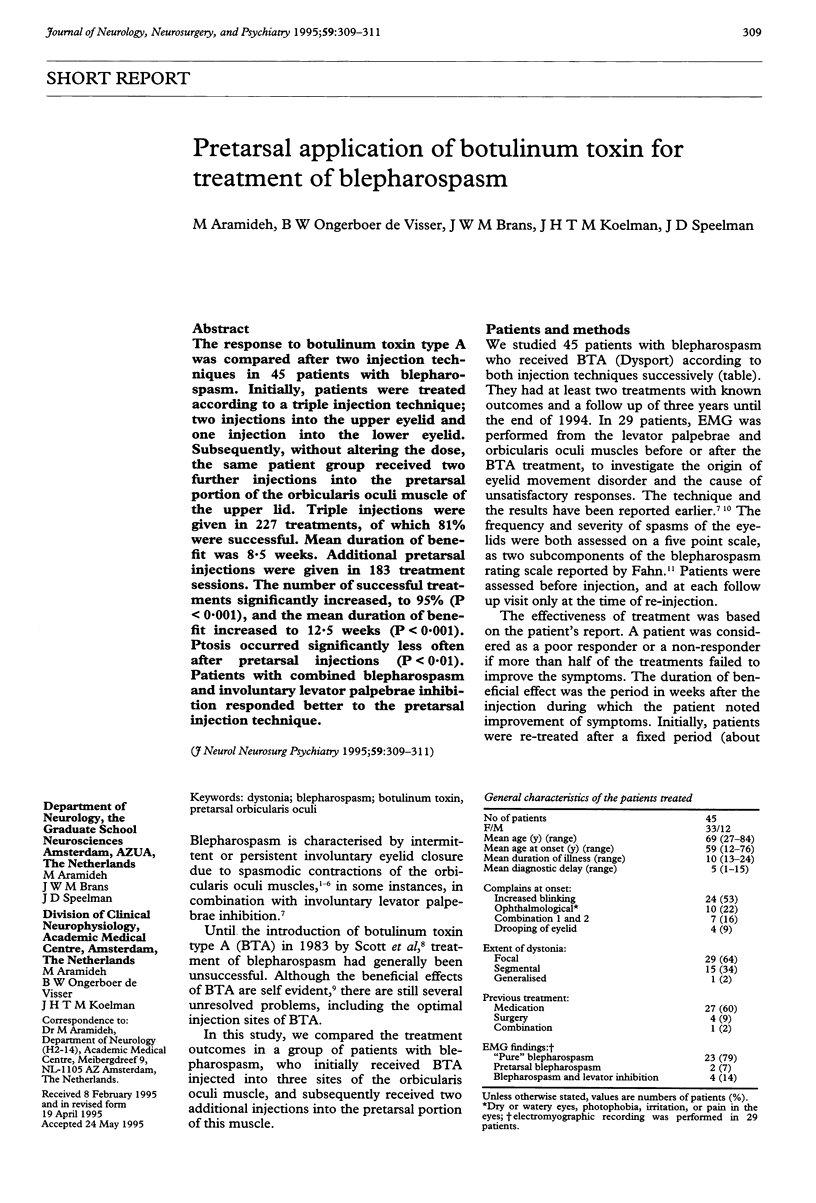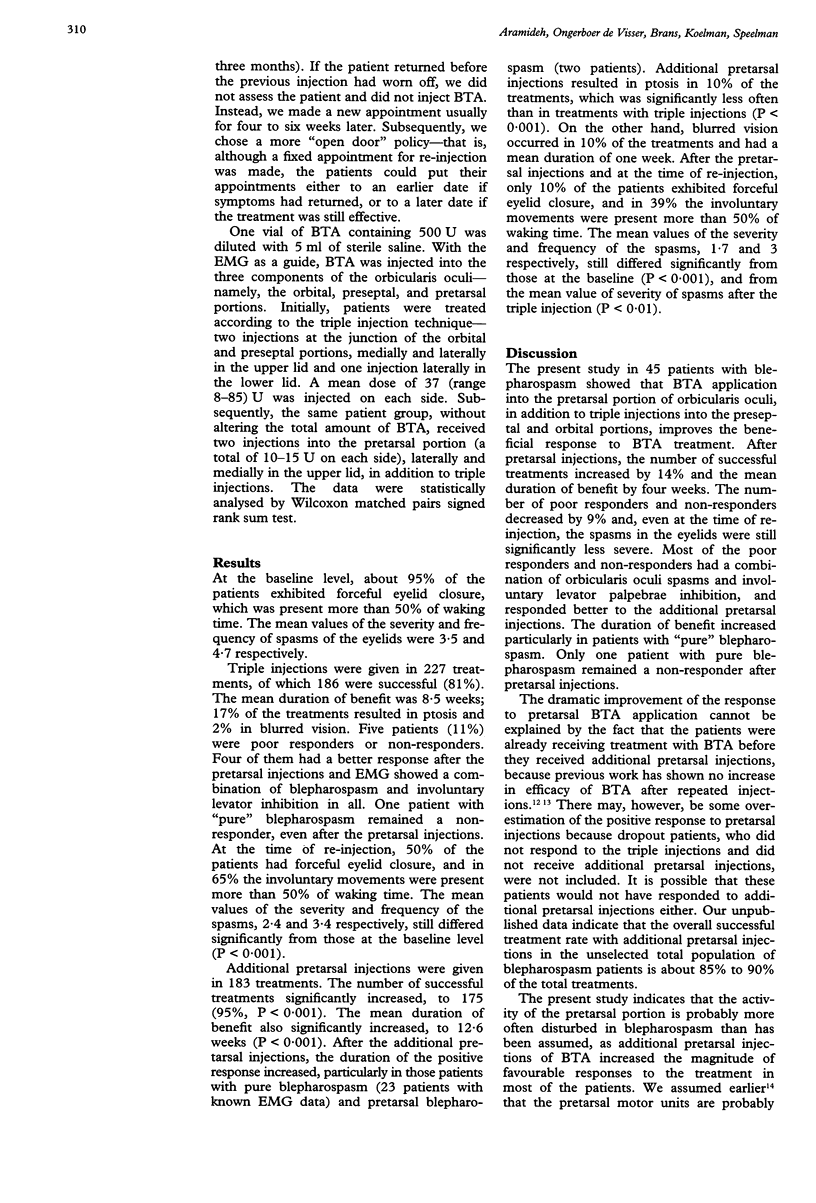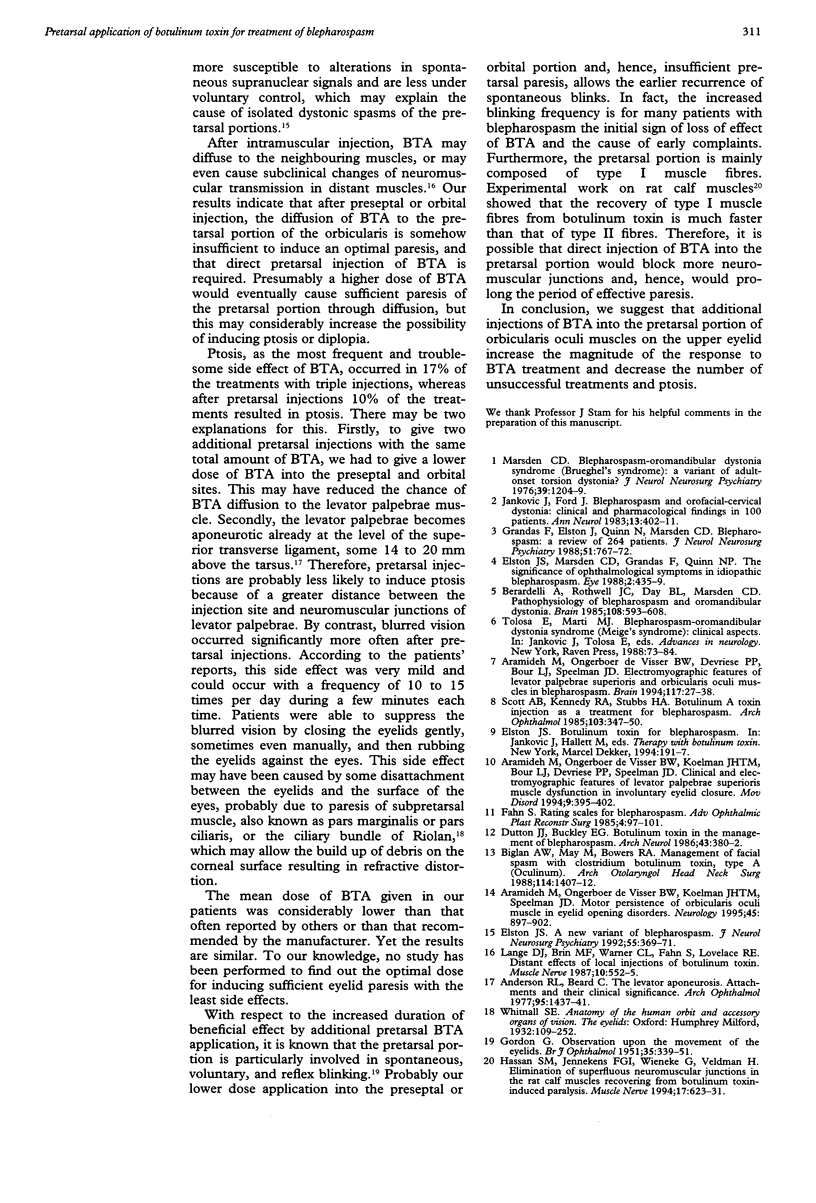Abstract
The response to botulinum toxin type A was compared after two injection techniques in 45 patients with blepharospasm. Initially, patients were treated according to a triple injection technique; two injections into the upper eyelid and one injection into the lower eyelid. Subsequently, without altering the dose, the same patient group received two further injections into the pretarsal portion of the orbicularis oculi muscle of the upper lid. Triple injections were given in 227 treatments, of which 81% were successful. Mean duration of benefit was 8.5 weeks. Additional pretarsal injections were given in 183 treatment sessions. The number of successful treatments significantly increased, to 95% (P < 0.001), and the mean duration of benefit increased to 12.5 weeks (P < 0.001). Ptosis occurred significantly less often after pretarsal injections (P < 0.01). Patients with combined blepharospasm and involuntary levator palpebrae inhibition responded better to the pretarsal injection technique.
Full text
PDF


Selected References
These references are in PubMed. This may not be the complete list of references from this article.
- Anderson R. L., Beard C. The levator aponeurosis. Attachments and their clinical significance. Arch Ophthalmol. 1977 Aug;95(8):1437–1441. doi: 10.1001/archopht.1977.04450080147019. [DOI] [PubMed] [Google Scholar]
- Aramideh M., Ongerboer de Visser B. W., Devriese P. P., Bour L. J., Speelman J. D. Electromyographic features of levator palpebrae superioris and orbicularis oculi muscles in blepharospasm. Brain. 1994 Feb;117(Pt 1):27–38. doi: 10.1093/brain/117.1.27. [DOI] [PubMed] [Google Scholar]
- Aramideh M., Ongerboer de Visser B. W., Koelman J. H., Bour L. J., Devriese P. P., Speelman J. D. Clinical and electromyographic features of levator palpebrae superioris muscle dysfunction in involuntary eyelid closure. Mov Disord. 1994 Jul;9(4):395–402. doi: 10.1002/mds.870090404. [DOI] [PubMed] [Google Scholar]
- Aramideh M., Ongerboer de Visser B. W., Koelman J. H., Speelman J. D. Motor persistence of orbicularis oculi muscle in eyelid-opening disorders. Neurology. 1995 May;45(5):897–902. doi: 10.1212/wnl.45.5.897. [DOI] [PubMed] [Google Scholar]
- Berardelli A., Rothwell J. C., Day B. L., Marsden C. D. Pathophysiology of blepharospasm and oromandibular dystonia. Brain. 1985 Sep;108(Pt 3):593–608. doi: 10.1093/brain/108.3.593. [DOI] [PubMed] [Google Scholar]
- Biglan A. W., May M., Bowers R. A. Management of facial spasm with Clostridium botulinum toxin, type A (Oculinum) Arch Otolaryngol Head Neck Surg. 1988 Dec;114(12):1407–1412. doi: 10.1001/archotol.1988.01860240057024. [DOI] [PubMed] [Google Scholar]
- Dutton J. J., Buckley E. G. Botulinum toxin in the management of blepharospasm. Arch Neurol. 1986 Apr;43(4):380–382. doi: 10.1001/archneur.1986.00520040060020. [DOI] [PubMed] [Google Scholar]
- Elston J. S. A new variant of blepharospasm. J Neurol Neurosurg Psychiatry. 1992 May;55(5):369–371. doi: 10.1136/jnnp.55.5.369. [DOI] [PMC free article] [PubMed] [Google Scholar]
- Elston J. S., Marsden C. D., Grandas F., Quinn N. P. The significance of ophthalmological symptoms in idiopathic blepharospasm. Eye (Lond) 1988;2(Pt 4):435–439. doi: 10.1038/eye.1988.79. [DOI] [PubMed] [Google Scholar]
- GORDON G. Observations upon the movements of the eyelids. Br J Ophthalmol. 1951 Jun;35(6):339–351. doi: 10.1136/bjo.35.6.339. [DOI] [PMC free article] [PubMed] [Google Scholar]
- Grandas F., Elston J., Quinn N., Marsden C. D. Blepharospasm: a review of 264 patients. J Neurol Neurosurg Psychiatry. 1988 Jun;51(6):767–772. doi: 10.1136/jnnp.51.6.767. [DOI] [PMC free article] [PubMed] [Google Scholar]
- Hassan S. M., Jennekens F. G., Wieneke G., Veldman H. Elimination of superfluous neuromuscular junctions in rat calf muscles recovering from botulinum toxin-induced paralysis. Muscle Nerve. 1994 Jun;17(6):623–631. doi: 10.1002/mus.880170609. [DOI] [PubMed] [Google Scholar]
- Jankovic J., Ford J. Blepharospasm and orofacial-cervical dystonia: clinical and pharmacological findings in 100 patients. Ann Neurol. 1983 Apr;13(4):402–411. doi: 10.1002/ana.410130406. [DOI] [PubMed] [Google Scholar]
- Lange D. J., Brin M. F., Warner C. L., Fahn S., Lovelace R. E. Distant effects of local injection of botulinum toxin. Muscle Nerve. 1987 Jul-Aug;10(6):552–555. doi: 10.1002/mus.880100610. [DOI] [PubMed] [Google Scholar]
- Marsden C. D. Blepharospasm-oromandibular dystonia syndrome (Brueghel's syndrome). A variant of adult-onset torsion dystonia? J Neurol Neurosurg Psychiatry. 1976 Dec;39(12):1204–1209. doi: 10.1136/jnnp.39.12.1204. [DOI] [PMC free article] [PubMed] [Google Scholar]
- Scott A. B., Kennedy R. A., Stubbs H. A. Botulinum A toxin injection as a treatment for blepharospasm. Arch Ophthalmol. 1985 Mar;103(3):347–350. doi: 10.1001/archopht.1985.01050030043017. [DOI] [PubMed] [Google Scholar]
- Tolosa E., Martí M. J. Blepharospasm-oromandibular dystonia syndrome (Meige's syndrome): clinical aspects. Adv Neurol. 1988;49:73–84. [PubMed] [Google Scholar]


